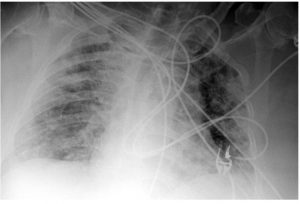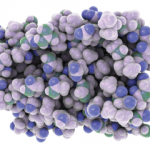His medical history was significant for ankylosing spondylitis, hypertension, hypothyroidism, benign prostatic hypertrophy, supraventricular tachycardia with ablation, neuropathy and hyperlipidemia. His medications included secukinumab 150 mg subcutaneous every four weeks for the previous 16 months, amlodipine, hydrochlorothiazide, losartan, nortriptyline, levothyroxine, rosuvastatin and tamsulosin.
On admission, the patient’s vital signs were: temperature 38.2° C, respiration rate 22 breaths/minute, blood pressure 179/78 mmHg, pulse oximeter 98% on room air. His weight was 152 kg. On physical exam, he had clear breath sounds on auscultation and no evidence of a murmur. The remainder of his physical exam was within normal limits.
His laboratory values on admission included a sodium level of 133 mmol/L (RR: 135–146), chloride of 95 mmol/L (RR: 96–107), glucose of 107 mg/dL (RR: 70–99), BNP 659 pg/mL (<450 pg/mL). His complete blood count showed thrombocytopenia 141,000/mm3 (RR: 150,000–450,000). His lymphocyte count was normal at 1,150/mm3 (RR: 900–4,800). His CRP was 1.9 mg/dL (RR: 0–0.5).
His chest X-ray on admission was clear and free of infiltrates.
Over the next three days, the patient continued to have fevers and became progressively dyspneic, requiring supplemental oxygen. A chest CT performed on day 2 showed several small areas of groundglass opacities (see Figure 1). On day 3 his lactate dehydrogenase was 611 IU/L, ferritin 843 ng/mL, D-dimer 246 ng/mL and CRP 11.7 mg/dL (all higher than normal ranges). A nasopharyngeal swab obtained on admission was positive for SARS-CoV-2 by PCR.

Figure 2. The husband’s day 4 chest X-ray showed interval development of diffuse patchy airspace opacities bilaterally.
On day 4, the patient’s condition worsened. He became more hypoxemic due to interval development of diffuse patchy airspace opacities bilaterally on chest X ray (see Figure 2) requiring intubation and mechanical ventilation. On day 7, the patient remained on mechanical ventilation. He completed a five-day course of hydroxychloroquine, azithromycin and steroids. Secukinumab was not administered during the hospitalization.
Discussion
Severe acute respiratory syndrome coronavirus 2 (SARS-CoV-2) is an RNA virus first reported in Wuhan, Hubei Province, China, in December 2019.1 As of April 7, more than 1.2 million people worldwide had been confirmed with COVID19 infection, and more than 72,000 deaths had occurred.2 Mortality is higher in the elderly, but little is known about COVID-19 infection in immunocompromised patients, particularly those with rheumatic diseases on biologics.
We report two cases of a husband and wife, both receiving different disease-modifying anti-rheumatic drugs (DMARDs), with markedly different clinical presentations and hospital courses. The wife, a patient with rheumatoid arthritis who received etanercept and methotrexate prior to hospitalization, had a very mild clinical course that required no major therapeutic intervention. Her husband, with ankylosing spondylitis, had received secukinumab and progressed to critical COVID-19 disease requiring mechanical ventilation.



